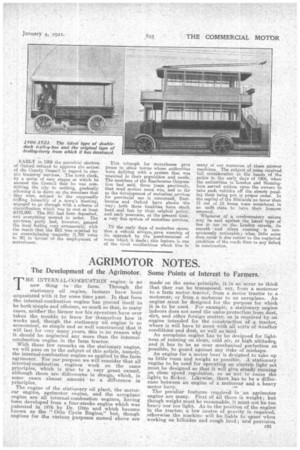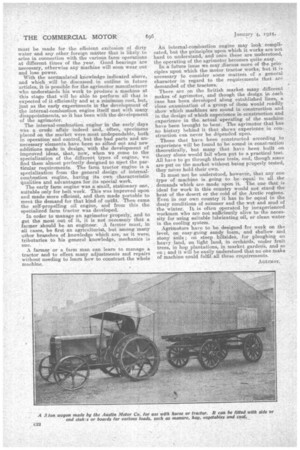AGRIMOTOR NOTES.
Page 21

Page 22

If you've noticed an error in this article please click here to report it so we can fix it.
The Development of the Agrimotor. Some Points of Interest to Farmers.
HE INTERNAL-COMBUSTION engine. is no new . thing to • the farm: Through the stationary oil engine, farmers have been acquainted with it for some tithe past. In that form theinternal-combustion engine has proved itself to. be both-simple and efficient, so much. so that, in many cases, neithet the farmer nor his operators have ewer taken the trouble to learn for theniselves how it works and, though the stationary oil engine is so economical, so simple and so well constructed that it will last for very many years, this is no reason why it should be neglected any more than the internalcombustion engine in the farm tractor. With these Few remarks on the stationary engine, we will pass on to the subject of this article, namely, the internal-combustion engine as applied to the farm agrimotor. For our purpose we will consider that all internal-combustion . engines work On the same principles, 'which is true to a very great extent, although there are differences in design, which, in some cases almost amount to a difference in principles.
The engine of the stationary oil plant, the motorcar engine, agrimotor engine, and the aeroplane engine are all internal-combustion engines, having been developed froma four-stroke engine which was patented in 1876 by Dr. Otto and which became known as the "Otto Cycle Engine," but, though engines for the various purposes named above are made on the same principle, it is an ,error to think that they can be transposed, say, from a motorcar to a farm motor.tractor, from a motor tractor to a, motorcar, or .from a motorcar to an aeroplane. An engine.must be designed for the purpose for which it -is to be used. Forexample, a. stationary engine indoors does not need the same protection from. dust, dirt, and other foreign matter, as is required by an engine intended for the construction. of a tractor, where it will have to meet with all sorts of weather conditions and dust, as well as Mud. Au aeroplane engine has to be designed for lightness.of running on clean, cold air, at high altitude, and it has to be as near mechanical perfection as possible, to guard against any risks of mishaps. An engine for a motor boat is designed to take .up As little room and weight as possible. A stationary engine to be used for operating an electric light set must be designed so that it will give steady running on close speed regulation, so as not to cause the lights to flicker. Likewise, there has to be a difference between an engine of a, motorcar and a heavy motor lorry. The peculiar features required: in an agrirnotor engine are many. First of all there is weight ; but though weight must be reasonable, it must not be too heavy nor too light. As to the position of the engine' in the tractor, a low centre of gravity is required, otherwise the machine will be liable to upset when working on hillsides And rough land ; and provision must be made for the efficient exclusion of dirty water and any other, foreign matter that is likely, to arise in connection with the various farm operations at different times of the year. Good bearings are necessary, otherwise any machine will soon wear out and lose power. With the accumulated knowledge indicated above, and which will be discussed in outline in future articles, it is possible. for the agrimotor manufacturer who understands his work to produce a machine at this stage that will be able to perform all that is expected of it efficiently and at a minimum cost, but, just as the early experiments in the development of the internal-combustion engine itself met with 'many disappointments, so it has been with the development of the agrimotor.
The internal-combustion engine' in the early days was a crude affair indeed and,. often, specimens placed on the market were most undependable, both in operation. and control, but the bad parts and unnecessary elements have been so sifted out and new additions made in design; with the development or improved ideas, that, now, when we come to the specialization of the different types Of engine, we find them almost perfectly designed to meet the particular requirements. The farm tractor engine is a specialization from the general design of internalcombustion engine, having its own characteristic qualities and advantages for its special work. The early farm engine was a small, stationary one, suitable only for belt work. This was improved upon and made more efficient, and then made portable to meet the demand" for that kind of outfit. Then came the self-propelling oil engine, and from this the specialized farm tractor was developed. • In order to manage an agrimotor properly, and to get the most out of it, it is not necessary that a farmer should be . an engineer. A farmer must, in all cases, be first an agriculturist, but among 'many ether branches of knowledge which are, as it were, tributaries to his general knowledge, mechanics is one.
A farmer or a farm man can learn to manage a tractor and to effect many adjustments and repairs without needing to learn how to construct the whole machine. An internal-combustion .engine may look complicated, but the principles upon which it works are not hard to understand, and once these are -understood, the operating of the agrimotor becomes quite easy. In a future issue we may discuss more of the principles upon which the motor tractor works, but it is necessary to consider some matters of a general character in regard to the requirements that are demanded of the tractors.
• There are on the British market many different makes of agrimotor, and though the design in .each Case has been developed along established lines, a close examination of a group of them would readily show which machines are sound in construction and in the design of which experience in construction and experience in the actual operating of the machine have been brought to bear. The agrimotor that has no history behind it that shows experience in construction can never be chipended upon.
Those that have been constructed according to experience will be found to be sound in construction theoretically, but many that have been. built on theory alone would fail when put to a practical test. All have to go through these tests, and, though some are put on the market without being properly tested, they never hold their own.
It must not be understood, however, that any one type of machine is going to be equal to all the demands which are made upon it. The one that is ideal for work in this country would not stand the heat of the desert or the cold of the Arctic regions.
Even in our own country it has to be equal to the dusty conditions of summer and the wet and mud of the winter. It is often operated by inexperienced workmen who are not. sufficiently alive to the neces, sity for using suitable lubricating oil, or clean water in the cooling system.
Agrimotors -have to be designed for work on the level, on easy-going sandy loam, and shallow and stony soils ; on steep hillside, for ploughing on heavy land, on light land, in orchards, under fruit. trees, in hop plantations, in market garden's, and so on ; and it will be easily understood that no one make of machine could fulfil all these requirements.




























